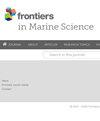韩国沿海水产养殖系统夏季水化学成分和沉积有机物的鉴别特征
IF 2.8
2区 生物学
Q1 MARINE & FRESHWATER BIOLOGY
引用次数: 0
摘要
了解沿海环境中沉积有机物(OM)的空间分布和来源对于有效管理水质和保护生态系 统健康至关重要。尽管对 OM 动态进行了广泛的研究,但在了解韩国沿海水产养殖区(尤其是夏季)正在进行的生物地球化学过程方面仍存在差距。针对这一空白,我们研究了水化学特性和沉积 OM 同位素组成的空间变化,以追踪夏季韩国沿海水产养殖系统中混合 OM 的组成、来源和反应性。同位素方法适用于西部(W)-1、W-2、南部(S)-1、S-2 和东部(E)-1 五个断面的表层沉积物。由于 W 区段附近的大坝排水增加了营养物质(主要是硝酸盐;1.2 ± 0.6 mg/L),我们的同位素特征显示,沉积 OM 的很大一部分可能主要来源于自生 OM 源(藻类;36.5%),这与陆地营养物质的增加有关。同时,在 S-2 断面中,异源 OM(水产养殖粪便;44%)沉积占主导地位。S-2 段的 34S 贫化模式(约-7.2‰)表明沉积边界发生了活跃的硫酸盐还原作用。因此,结合正在进行的 OM 的精确测定,我们的同位素结果为在人为污染增加的情况下有效管理水-沉积质量提供了宝贵的见解。本文章由计算机程序翻译,如有差异,请以英文原文为准。
Discriminative characteristics of hydrochemical components and sedimentary organic matter in Korean coastal aquaculture systems during summer
Understanding the spatial distribution and sources of sedimentary organic matter (OM) in coastal environments is crucial for effective water quality management and the preservation of ecosystem health. Although extensive research has been conducted on OM dynamics, there remains a gap in understanding the ongoing biogeochemical processes in Korean coastal aquaculture zones, particularly during the summer season. To address this gap, we investigated the spatial variation of water chemical properties and isotopic composition of sedimentary OM to trace the composition, source, and reactivity of mixed OM in aquaculture systems along the Korean coast during the summer season. The isotopic approach was applied to surface sediments from five sections: western (W)-1, W-2, southern (S)-1, S-2, and eastern (E)-1. With respect to increased nutrients (mainly nitrate; 1.2 ± 0.6 mg/L) by dam-water discharge near W sections, our isotopic signatures revealed that a substantial fraction of sedimentary OM might dominantly originated from autochthonous OM source (algae; 36.5%) related to the increase of terrestrial nutrients. Simultaneously, the deposition of allochthonous OM (aquacultural feces; 44%) was predominant in the S-2 sections. The 34 S-depleted patterns (approximately -7.2‰) in the S-2 section was indicative of active sulfate reduction occurring at the sedimentary boundary. Therefore, together with the precise determination of ongoing OM, our isotopic results provide valuable insights for effectively managing water-sedimentary qualities under the increase of anthropogenic contamination.
求助全文
通过发布文献求助,成功后即可免费获取论文全文。
去求助
来源期刊

Frontiers in Marine Science
Agricultural and Biological Sciences-Aquatic Science
CiteScore
5.10
自引率
16.20%
发文量
2443
审稿时长
14 weeks
期刊介绍:
Frontiers in Marine Science publishes rigorously peer-reviewed research that advances our understanding of all aspects of the environment, biology, ecosystem functioning and human interactions with the oceans. Field Chief Editor Carlos M. Duarte at King Abdullah University of Science and Technology Thuwal is supported by an outstanding Editorial Board of international researchers. This multidisciplinary open-access journal is at the forefront of disseminating and communicating scientific knowledge and impactful discoveries to researchers, academics, policy makers and the public worldwide.
With the human population predicted to reach 9 billion people by 2050, it is clear that traditional land resources will not suffice to meet the demand for food or energy, required to support high-quality livelihoods. As a result, the oceans are emerging as a source of untapped assets, with new innovative industries, such as aquaculture, marine biotechnology, marine energy and deep-sea mining growing rapidly under a new era characterized by rapid growth of a blue, ocean-based economy. The sustainability of the blue economy is closely dependent on our knowledge about how to mitigate the impacts of the multiple pressures on the ocean ecosystem associated with the increased scale and diversification of industry operations in the ocean and global human pressures on the environment. Therefore, Frontiers in Marine Science particularly welcomes the communication of research outcomes addressing ocean-based solutions for the emerging challenges, including improved forecasting and observational capacities, understanding biodiversity and ecosystem problems, locally and globally, effective management strategies to maintain ocean health, and an improved capacity to sustainably derive resources from the oceans.
 求助内容:
求助内容: 应助结果提醒方式:
应助结果提醒方式:


